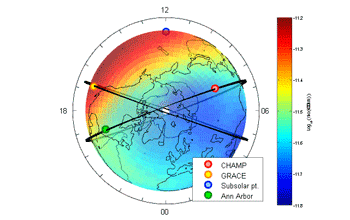Multimedia Gallery
Models of orbiting satellites in the thermosphere were improved using data assimilation.
Solar radiation in the thermosphere (the layer of the Earth's atmosphere directly above the mesosphere and directly below the exosphere) significantly affects the drag experienced by objects like satellites and spacecraft in low-Earth orbit. The fact that the drag changes depending on several factors leads to uncertainty in the position of objects in orbit, which could result in the loss of a spacecraft. Here, we see animation of orbiting satellites responding to the atmosphere. The DART data assimilation reduced up to 70 percent of the bias from the Global Ionosphere-Thermosphere Model.
Credit: Alexey Morozov, University of Michigan
Images credited to the National Science Foundation, a federal agency, are in the public domain. The images were created by employees of the United States Government as part of their official duties or prepared by contractors as "works for hire" for NSF. You may freely use NSF-credited images and, at your discretion, credit NSF with a "Courtesy: National Science Foundation" notation.
Additional information about general usage can be found in Conditions.
Also Available:
Download the high-resolution GIF version of the image. (439.4 KB)
Use your mouse to right-click (Mac users may need to Ctrl-click) the link above and choose the option that will save the file or target to your computer.
Related story: Confronting models with observations



